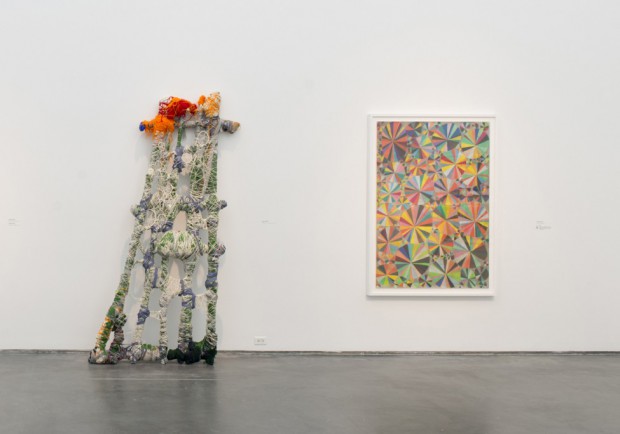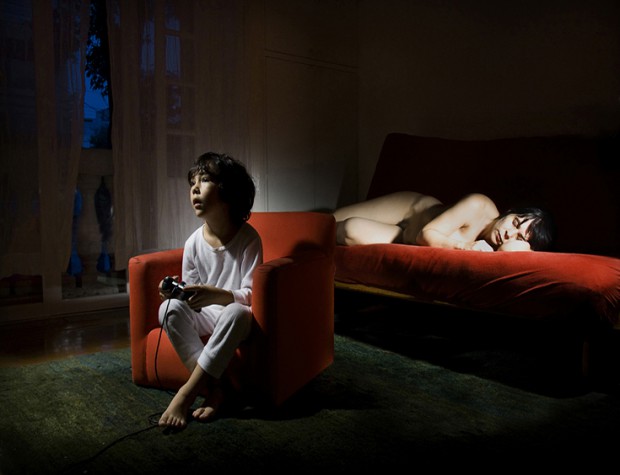Home Truths: Photography and Motherhood
April 18 – July 23, 2014
Museum of Contemporary Photography
Columbia College, 600 South Michigan Avenue
What’s on view: Photographic series on the theme of motherhood by each of the artists: Janine Antoni, Elina Brotherus, Elinor Carucci, Ana Casas Broda, Ann Fessler, Tierney Gearon, Fred Hüning, Katie Murray, and Hanna Putz.
Robin Dluzen: On the ground floor of the museum, we first encountered Elina Brotherus’s series documenting her failed attempts at in vitro fertilization, Fred Hüning’s narrative family photos, and Elinor Carucci’s self-portraits as a new mother. Though the works of these three artists read as honest and vulnerable, I admit that I left wanting more from a motherhood themed-exhibition than work about the pains and joys of pregnancy. Luckily, we got out of that situation once we moved on to the other floors.
For some of the better work, there was Katie Murray’s video of herself on a Gazelle workout machine with both of her children hanging onto her, juxtaposed with wildlife footage of lions attempting to bring down a real gazelle in the savanna. It brought some humor to the show, seen through the subject of post-baby body issues. Tierney Gearon’s photos of her children with their mentally ailing grandmother (the artist’s mother) are some of the only pieces in the show addressing motherhood in a wider scope, far beyond that of birthing and raising young children.
Damien James: I felt that Carucci’s work was intimate and even sweet. But the ideas about identity were more succinctly exposed on the second floor. Here I’m thinking of Murray’s video, and much more so with Ana Casas Broda.
In Broda’s photographs, she brought up how uncomfortable it is to be a mom. Her two sons, a toddler and a boy a few years his senior, drew on her naked body while simultaneously suckling her nipple and restraining her mouth—she seemed to become nothing more than a plaything for her two sons.
As a parent, I couldn’t relate to this. The work made me think she had quite literally given herself over to her children. In one photo, Broda – nude throughout the series – lays on the floor while her children cover her in whipped cream, in another they mummify her with toilet paper. In slightly more disturbing photo, Broda sits with her sons in a bathtub while they stand over her and pour something that looks like motor oil on her, her face entirely blackened and covered by the thick liquid. To that end, some of her images are a bit scary. The work also has a voyeuristic and erotic edge which seems to remove the artist from the process.
Robin Dluzen: Absolutely. Broda’s photos scared the crap out of me. As an unmarried person without children, I experienced these photos as an illustration of my worst nightmares of what motherhood could be like: two young boys practically devouring the woman, suffocating and draining her. Indeed, in her artist statement, Broda references the internal distress and the “monsters” that come about as a result of exhaustion and insomnia. Shadowy and high contrast, the photos are cinematic and fantastical, like in any number of horror movies.
I don’t see much of an erotic side, like you did. In fact, it’s almost the opposite. Yes, the boys are interacting intimately with Broda’s nude body, but in many of the scenarios her body is hardly treated as a person, much less as a woman. For instance, the scene in which the boys are drawing on her nude body, the children treat her body like an asexual object or a toy, and in some cases, her body is merely a site on which the boys’ actions occur. Objectified, yes, but not as a sex object.
Damien James: There’s one photo in particular that carried an erotic weight, of Broda on hands and knees atop the crumpled sheets of her bed. Her face is out of sight behind her hair, her skin puckered and sagging in places. Even her body, which has suffered the distress of childbirth, still retains what I see—at least in part—as the sexuality of a woman, a mother. Her body is a recipient of an ardor leading to childbirth.
Broda’s photos could certainly serve as a deterrent for women considering having families, but at the same time, the work feels extreme in regards to the selflessness of the mother. There is undoubtedly more to being a parent than any one show of photography can illuminate, but I do feel that as a whole, Home Truths touches on a few central issues. It elicits both sympathy and empathy, and expresses the overall heartache that comes from bringing another human into the world: the playful joy and wonder, the pain, and occasional horror.
Robin Dluzen: You’re right about the extreme selflessness. Maybe that’s a part of what makes it so scary.

Installation view, William J. O’Brien, MCA Chicago, 2014
Left: Untitled, 2008. Courtesy of the artist and Marianne Boesky Gallery, New York; right: Untitled, 2007. Collection of Dana Westreich Hirt
Photo: Nathan Keay, © MCA Chicago
William J. O’Brien
Jan 25 – May 18, 2014
Museum of Contemporary Art, Chicago
220 East Chicago Ave
What’s on view: Chicago-based artist William J. O’Brien’s first comprehensive solo museum exhibition spanning five galleries and featuring colorful, psychedelic drawings, gestural and textural paintings, hand-built ceramic forms, and wrapped and piled sculptures and installations.
Damien James: William J. O’Brien spans so many mediums with such exuberance that at times it felt like I was seeing work by several artists. There were free-standing and leaning sculptures of steel wrapped with string and bits and pieces of a number of materials, many of which had a haphazard and unfinished quality; ceramic busts and masks encompassing tribal and naïve aesthetics, and complex architectural constructions that didn’t connect to any of the other work in the show. The drawings were joyous and light in contrast with much of the sculpture.
Robin Dluzen: “Exuberance” is the perfect word to describe the show, and I can see how his freedom with materials is aesthetically inspiring, especially for artists. I, too, feel as though there could be more than one artist here, particularly because I feel like O’Brien’s practice is indicative of the work I see being made by Chicago artists. At any point in time, one can walk into a Chicago gallery and see an artist wrapping something in string or covering something with glitter. (Both artists linked here are excellent, by the way). The MFA shows are full of artists culling objects from thrift stores and piling them on a shelf with some studio detritus. I’m torn between appreciating that the museum is reflecting contemporary practices by featuring O’Brien’s work, and personally being a little tired of seeing this kind of work so often.
Damien James: It’s true, I’ve seen similar things being done all over Chicago, from the storefront pop-up galleries downtown to River North and the West Loop, artists are piling and wrapping and using applique. At times I feel like I’m looking at a mess that I can’t connect aesthetically. I’m fine with the thrift-store thrust of some work, but with O’Brien, what ultimately makes the show compelling is the strength of his drawing.
One untitled piece in particular that set the tone for many of the drawings is half covered in cleanly painted but loose asterisks, while the other side of the painting is largely dots in varying sized and lean lines of white dripping over them; all of these shapes in blues, reds, oranges, browns and greens, float above transparent stripes and more spangles of spots and broader strokes of color. O’Brien’s piling of color and shape in the drawings feels alive, whereas the similar heaped-on aspects in sculpture read as heavy and thick.
Robin Dluzen: Agreed. Though I appreciate that O’Brien’s work contributes to conversations about craft in contemporary art making, there are very few instances of individual pieces that impart much content on their own. The works definitely speak more en masse, which underscores his “more is more” aesthetic.



Comments on this entry are closed.